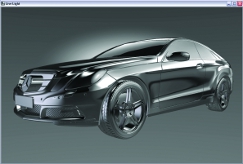HDRLightStudio 2.0 – Many of today’s rendering and visualisation tools rely on high dynamic range images (HDRI) to provide a quick, easy way of producing accurate lighting set-ups for your digital models. But what if you want to create a HDR image that absolutely nails your render first time? Al Dean reports
The use of realistic lighting is essential in the world of computer generated imagery (CGI). The problem is that it can often be a difficult and time-consuming process.

The use of High-Dynamic Range (HDR) imagery makes things easier, but off the shelf data is sometimes not enough for the perfectionist.
Enter HDRLightStudio from UK developer, Lightmap, which brings unseen levels of usability and control to HDR-based rendering. HDR images record a greater level of information about light in a particular environment than is stored in normal images.
They not only capture the colour at each pixel, but also the intensity of that colour (or light, much the same thing). In the rendering world, HDRs are typically used to provide lighting information for a scene by loading a 360° panorama. Off the shelf HDR rendering systems usually come with a few standard files in the box or they can be downloaded from various online sources.
All too often, reliance is placed on stock or standard HDRIs that are supplied with your rendering tool of choice or acquired from other sources
But what if you’re looking for more control? What if you’re looking to supplement HDR images with photo studio style lighting? What if the HDR images you have to hand don’t work with your product or give the reflections you’re looking for?
This is where things can get complex. One answer is to rent a Spheron camera and shoot your own. This special purpose camera can capture a physical scene and make it available in the digital world, but the process is costly and time consuming.
Another option is to dive into Photoshop and create one from scratch. This is cheaper but still takes valuable time. The final option is to create a lighting rig in your rendering system, but this is also time consuming, particularly for those less experienced in design visualisation.
To solve these issues and more, Lightmap’s HDRLightStudio steps into the fray, so let’s take a look.
Creating HDR images from scratch
The system provides a range of functionality for creating HDRI-based lighting scenes from scratch. There’s a wide range of tools for adapting colour backgrounds (whether plain or gradientbased) onto which lights are then added.
These are either based on generic shapes or chosen from a stock of more realistic replicas of photographers’ light props, such as spotlights and bounce cards.
They can be positioned and adapted for size and intensity and are perfect for creating a photo-studio like lighting environment. All of this was available in the first release of the software, but what’s changed in 2.0 is the introduction of LiveLight.
The problem with version 1 was it was often difficult to gauge the effect of your changes unless you loaded the HDR into a rendering tool and did a test render. LiveLight removes the need to do this by providing a real-time preview window.
While the preview is built with a default 3D object as standard (a teapot of course), you can drag and drop an OBJ or MI (mental image file). When the HDR is changed, it immediately shows the preview, so you can see exactly how edits affect shadows, reflections and highlights.
The model can be rotated and inspected, so when you do get round to loading it into your rendering tool, it should be about perfect and only need minor tweaking.
Additionally, if you import the files from 3ds Max or Softimage, then the system will match the camera you last saved the file in, so you have a perfect match for your final rendering.
Adapting existing photographic HDR images
While the tools we’ve discussed so far are best suited to creating photographic studio style lighting rigs, HDRLightStudio 2.0 also includes new tools to adapt photographicstyle HDRIs, such as those produced by a specialist camera.

The problem with these HDR images is that they are not always immediately ideal for rendering purposes. Once you review the captures, you may need to add spotlights, other lights or, indeed, remove some.
To assist with this, HDRLightStudio 2.0 allows HDR images to be loaded in and lights amended where required. Again, the LiveLight preview provides instant feedback on the position and highlights achieved.
HDRLightStudio 2.0 – Pricing
HDRLightStudio is offered in two variants: Standard and Pro. The main difference between the two is the resolution that final HDRIs can be rendered out to.
HDRLightStudio Standard allows you to export up to 5,000 x 2,500 pixels, which should be more than enough for the design/engineering focussed user. The Pro version is unlimited in its output.
It should also be noted that it is only possible to load HDR images and edit them with the Pro version. HDRLightStudio Pro also comes with a number of plug-ins that allow a more interactive way of working with a few different applications such as Right Hemisphere’s Deep Exploration 6.
Conclusion
As said at the outset, accurate lighting is key to nailing your rendering output, both in terms of realism and in terms of highlighting specific features or aspects of your product.
Get the lighting correct and it’s most of the way there. The problem is that even with the simplicity of using HDR images in tools like Maya, 3ds Max, KeyShot or Showcase, it’s still a time consuming process to fine tune and perfect those images.
All too often, reliance is placed on stock or standard HDRIs that are supplied with your rendering tool of choice or acquired from other sources.
HDRLightStudio offers a different path; one with control over everything relating to lighting and how your final image appears.
Today we’re seeing huge advances in rendering speed through the use of multicore CPUs, Graphics Processing Units (GPUs) or even the cloud. While increased compute power means you get your images back faster, it doesn’t mean the images will be better.
You’ll just have more of them, more quickly. With HDRLightStudio It is possible to ensure a critical part of the rendering process is ready to go with little fuss, meaning you can spend the rest of the time getting that image perfect.
| Product | HDRLightStudio 2.0 |
|---|---|
| Company name | Lightmap |
| Price | £399 to £599 |







